|
|
|
|
|
Oil On
Canvas, Real Flavor of Old Masters
|
|

|
ARTWORKS
INDEX
A B C D E F G H I J K L M N O P Q R S T U V W X Y Z |
ARTISTS
INDEX
A B C D E F G H I J K L M N O P Q R S T U V W X Y Z |
|
|
| | |
|
|
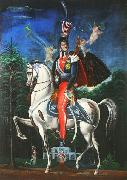 |
Zygmunt Waliszewski -- Click Here
|
|
(1897-1936) was a Polish painter, a member of the Kapist movement.
Waliszewski was born in Saint Petersburg to the Polish family of an engineer. In 1907 his parents moved to Tbilisi where Waliszewski spent his childhood. In Tbilisi began his studies at a prestigious art school. In 1908 he had his first exhibition and participated in the life of artistic avant-garde. During World War I he fought with the Russian army, returning to Tbilisi in 1917. He visited Moscow several times and became inspired by the Russian Futurists. He, later, became a member of a Futurist group. In the early 1920s, he departed for Poland, and settled in Krakew. Between 1921 and 1924 he studied at Academy of Fine Arts in Krakew in the studios of Wojciech Weiss and Jezef Pankiewicz. In 1924 he went to Paris with his avante-garde group and continued his studies in painting there under the guidance of Pankiewicz. He was a participant in the Capists' plein-air painting workshops in Cagnes, Valence, Cap Martin, and Avignon. At the Louvre, he painted copies and travesties of the works of old masters like Titian, Veronese, Velezquez, Vermeer, Goya, and Delacroix. He was also fascinated by the art of Cezanne, van Gogh, and Matisse.
In 1931 he returned to Poland, residing in Warsaw, Krzeszowice, and Krakew. During this time Waliszewski designed scenery and posters, created book illustrations, drew and painted caricatures and grotesque scenes. In Krakew he befriended the Polish Formists. Waliszewski painted primarily portraits and figural compositions and landscapes of the rural countryside. He died suddenly in 1936.
|
|
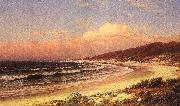 |
Yelland, William Dabb -- Click Here
|
|
American
1848-1900 |
|
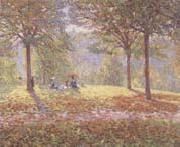 |
Wynford Dewhurst -- Click Here
|
|
British, 1864-1941
Wynford Dewhurst was born in Manchester in 1864. He was educated at home by a private tutor and later at Mintholme College. Although he originally trained to enter the legal profession, he showed artistic flair and decided to pursue a career as a painter after some of his drawings were published in various journals.
He gained his artistic training in France at the Ecole des Beaux-Arts, in Paris, where he was a pupil of the renowned French painter Jean-L??on Gerome. Despite his teacher Gerome rejection of the radical Impressionist movement in favour of a highly finished academic style (Gerome continued the development and conservation of French Neoclassicism), Dewhurst was heavily influenced by the Impressionists. It is well known that he first encountered Impressionism, to which he was instantly attracted, in the work of Emile Claus in the Maddocks Collection in Bradford. However his most important mentor would become Claude Monet.
It was Monet to whom Dewhurst dedicated his pioneering account of French Impressionism, Impressionist Painting: its genesis and development, in 1904. This was the first important study of the French painters to be published in English. As well as helping to reintroduce British artists to this style of painting, Dewhurst book called attention to the French Impressionists debt to the British artists John Constable and J. M. W. Turner, claiming that the Impressionists simply developed their existing painterly techniques. According to Dewhurst, artists who, like himself, painted in an impressionist manner, were often sneered at for imitating a foreign style, and he was keen to justify their position. French artists simply developed a style which was British in its conception, he wrote, a view that was dismissed by some French painters - such as Pissarro - who revealed his national bias when he acknowledged Constable and Turner but identified instead French influences like Nicolas Poussin, Claude Lorrain, Jean-Baptiste-Sim??on Chardin and Jean-Baptiste-Camille Corot. The thesis that Dewhurst put forward in Impressionist Painting was controversial for it dealt with the debated question of whether Impressionism was French or British in origin. However, it found much support in Britain: Kevin McConkey informs us that Dewhurst theme was taken up by others as various as Clausen, John Rothenstein and Kenneth Clark Nevertheless, Dewhurst detailed biographical notices of the most prominent artists associated with the rise of impressionism in France...leave little to be desired from the historical point of view. It is worth noting that Impressionist Painting also included an entire chapter on female artists, since modernity is the note of Impressionism, and that movement was the very first artistic revolt in which women took part. Indeed, Dewhurst thanks the celebrated female painter Mary Cassatt (who worked within the Impressionist circle) for her assistance in the preface of his book. |
|
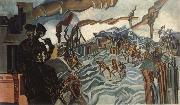 |
wyndham lewis -- Click Here
|
|
British painter and writer. He attended Rugby School and then studied painting at the Slade School of Art, London (1898-1901), where he earned a reputation both as a draughtsman and as a poet. His early artistic and intellectual mentors were Augustus John and Thomas Sturge Moore. From 1902 to 1908 Lewis travelled widely in Europe and studied in many of the major museums. He was one of the first British artists to be aware of, and interested in, Cubism and Expressionism, though little of his work before 1909 survives as evidence of his early development. In late 1908 Lewis settled in London and as well as painting began to publish satirical short stories that take a mechanistic view of human social behaviour, evident in the deliberately clumsy and grotesque figures in his art of the period 1909 to 1912. By 1910 he was including Cubist elements in his watercolour drawings (his preferred medium), and by 1912 he had developed his own linear vocabulary of forms, indebted to Cubist, Futurist and Expressionist forms, which gives an often ironic visual dimension to the themes of his fiction. Another important influence on his art was that of Japanese woodblock prints, as seen in the watercolour drawing later called The Vorticist (1912; Southampton, C.A.G.). By 1913 he was popularly seen as the leading British avant-garde artist.
|
|
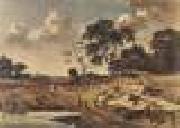 |
WYNANTS, Jan -- Click Here
|
|
Dutch Baroque Era Painter, ca.1630-1684 |
|
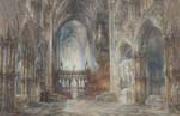 |
Wyke Bayliss -- Click Here
|
|
(October 21, 1835, Madeley, Shropshire - April 5, 1906, London) was a British painter, author and poet. He almost exclusively painted interiors of British and European churches and cathedrals, and was known in the late Victorian era as an academic authority on art. From the start of his career Bayliss' main interest was in depicting architecture, finding "infinite charm" in the "infinite variety of the aspect of a Cathedral interior".
His unusual first name was his mother Anne's maiden surname. His brother William Wyke Bayliss became a vicar and sister Elizabeth Anne Bayliss married a vicar, whilst a second sister Mary died as a teenager. Bayliss' wider family consisted of a number of luminaries. His great uncle was Thomas Turner, founder of the Caughley porcelain factory, a major leader in the development of the Willow pattern. Bayliss owned a portrait of Turner by Sir Joshua Reynolds as well as a number of further family portraits by Lemuel Francis Abbott . His second cousin was Sir William Maddock Bayliss.
Cologne Cathedral, pen and watercolourHis father, Rev. John Cox Bayliss was a railway engineer who taught military and mathematical drawing, and was also an artist known for his work "Views of Shropshire" published in 1839 . He gave his younger son training after he showed drawing aptitude at an early age. The family moved from Madeley to London following a job offer too good to refuse, giving Bayliss the opportunity to immerse himself in the emerging art scene of the early Victorian period. As a young student at the Royal Academy and the School of Design he became affiliated with the Pre-Raphaelites, and he counted amongst his friends John Millais, Frederic Leighton, William Holman Hunt and Edward Burne-Jones While distant from the Pre-Raphaelites in subject and technique, his paintings often reflect the juxtaposition of detail and colour that characterise much of Millais' and Leighton's work. Frederick Wedmore states in the foreword to Bayliss' autobiography "On reflection it will be seen that Wyke Bayliss had his speciality pretty well to himself. He was the inventor of his own genre - as well as his own method" . Bayliss paintings are held in many smaller UK and European collections, including the Atkinson Art Gallery in Southport (Evening: Amiens Cathedral) and the Welsh national collection. |
|
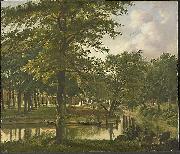 |
Wybrand Hendriks -- Click Here
|
|
(June 24, 1744, Amsterdam - January 28, 1831, Haarlem), was a Dutch painter and the concierge of the Teylers Museum.
According to the RKD he learned to paint while working for the decorative wall paper factory of J. Remmers in Amsterdam. From 1786 to 1819 he was the second concierge ("kastelein") of the Teyler's Stichting in Haarlem, where he lived at the "Fundatiehuis" as curator of the art collection, with his studio in the old drawing room of Teyler's drawing academy, which had itself been moved to the city hall. He assumed the position in 1785 after his predecessor Vincent Jansz van der Vinne had left in disagreement with Martin van Marum, the head of the fossil and instrument collections. As curator, he managed to purchase an important collection of Italian drawings from the collection of Queen Christina of Sweden in 1790.
He is known for portraits, landscapes, and flower still lifes in the manner of Jan van Huysum.
|
|
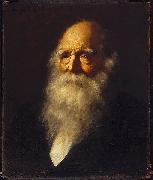 |
Wyatt Eaton -- Click Here
|
|
(May 6, 1849 - June 7, 1896) was an Canadian/American portrait and figure painter, remembered as one of the founders of the Society of American Artists.
Born in Philipsburg, Quebec, Lower Canada, Eaton was a student of the National Academy of Design, New York. In 1872, he moved to Paris and studied at the École des Beaux-Arts under Jean-Leon Gerôme. During this time, he made the acquaintance of Jean-François Millet at Barbizon, and was also influenced by his friend Jules Bastien-Lepage.
After his return to the United States in 1877, he became a teacher in the Cooper Institute, and opened a studio in New York City. He became one of the founders of the Society of American Artists, in which he was the first secretary. Eaton died from tuberculosis at Newport, Rhode Island on June 7, 1896.
|
|
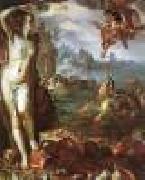 |
WTEWAEL, Joachim -- Click Here
|
|
Dutch painter (b. 1566, Utrecht, d. 1638, Utrecht).
Dutch painter and draughtsman. He was one of the last exponents of MANNERISM. From c. 1590 until 1628, the year of his latest known dated paintings, he employed such typical Mannerist formal devices as brilliant decorative colour, contrived spatial design and contorted poses. He sometimes combined such artifice with naturalism, and this amalgam represents the two approaches Dutch 16th- and 17th-century theorists discussed as uyt den geest ('from the imagination') and naer 't leven ('after life'). Wtewael's activity reflects the transition from Mannerism to a more naturalistic style in Dutch art. Slightly over 100 of his paintings and about 80 drawings are known. Subjects from the Bible and mythology predominate; |
|
 |
WRIGHT, Joseph -- Click Here
|
|
English painter (b. 1734, Derby, d. 1797, Derby).
Painter, known as Wright of Derby, where he was born and spent most of his life. He earned a living as a portrait painter, while he experimented with the effects of light and industrial and scientific subjects, reflecting the interests of his day. Two of his best-known works come from this period, A Philosopher Lecturing on the Orrery (1766, Derby) and An Experiment on a Bird in the Air Pump (1768, Tate). |
|
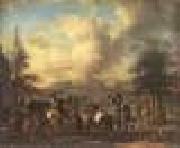 |
WOUWERMAN, Philips -- Click Here
|
|
Dutch Baroque Era Painter, 1619-1668. Dutch painters from Haarlem. Dutch painter and draughtsman. He was the eldest son of the painter Paulus [Pauwels] Joostens Wouwerman of Alkmaar (d 28 Sept 1642), whose two other sons, Pieter Wouwerman (1623-82) and Johannes Wouwerman (1629-66), also became painters. Philips probably received his first painting lessons from his father, none of whose work has been identified. According to Cornelis de Bie, Wouwerman was next apprenticed to Frans Hals, although no trace of Hals's influence is discernible in Wouwerman's work. Wouwerman is also reputed to have spent several weeks in 1638 or 1639 working in Hamburg in the studio of the German history painter Evert Decker (d 1647). While in Hamburg, he married Annetje Pietersz. van Broeckhof. On 4 September 1640 Wouwerman joined the Guild of St Luke in Haarlem, in which in 1646 he held the office of vinder (agent or 'finder'). Given the many southern elements in his landscapes, it has repeatedly been suggested that Wouwerman must have travelled to France or Italy, but there is no documentary evidence that he left his native Haarlem for more than short periods. During his lifetime he must have attained a certain degree of prosperity, as demonstrated by the relatively large sums inherited by each of his seven children after his wife's death in 1670. |
|
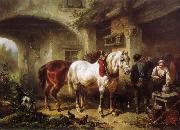 |
Wouterus Verschuur -- Click Here
|
|
(11 June 1812 - 4 July 1874) was a Dutch painter of animal subjects - mainly horses - and of landscapes. He is one of the later representatives of Romanticism in Dutch art.
Born to an Amsterdam jeweller, Verschuur received his training from the landscape and cattle painters Pieter Gerardus van Os and Cornelis Steffelaar. As part of this education Verschuur had to copy works by the 17th century painter Philips Wouwerman, like Wouwerman Verschuures subjects consist mostly of stable scenes, landscapes with horses and coastal landscapes.
Showing talent from an early age, at 15 Verschuur had a painting exhibited at the eExhibition of Living Masterse at Amsterdam in 1828. In 1832 and 1833 he won the gold medal at the annual exhibition at Felix Meritis. In 1833 he was appointed a member of the Royal Academy in Amsterdam. In 1839 he joined the artistse society, Arti et Amicitiae. His reputation was also considerable abroad. He was often featured in the annual exhibitions which travelled the large European cities at that time. In 1855 Napoleon III purchased one of his paintings at the Exposition Universelle in Paris.
The popularity of his paintings provided him with sufficient funds to travel widely. He made frequent trips to Gelderland and Brabant and abroad to Switzerland and Germany. In 1874, on one of his trips to Gelderland, he died on July 4 in the town of Vorden. He left behind an oevre of about 400 paintings and over 2000 drawings. Amongst his students were his son, Wouterus Verschuur Jr. and Anton Mauve.
|
|
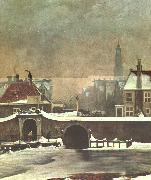 |
Wouter Johannes van Troostwijk -- Click Here
|
|
1782-1810
Dutch
Wouter Johannes van Troostwijk Gallery
Dutch painter, draughtsman and etcher. In 1803 he was admitted to the Amsterdam Tekenacademie where he was a pupil of the director, Jurriaan Andriessen. Despite a highly successful student career that culminated in a gold medal from the Felix Meritis Society in 1807, he was unable to establish himself as a professional artist during the remainder of his very short working life in Amsterdam. Andriessen's studies from nature seem to have been an important influence; van Troostwijk was one of the earliest artists to paint en plein air. Although he looked back to 17th-century Dutch landscape art and to the work of his contemporaries, in such paintings as Landscape in Gelderland (c. 1808; Amsterdam, Rijksmus.; see NETHERLANDS, THE, fig. 21) he achieved a totally new lyricism in the rendering of atmospheric effects. The Raampoortje (1809; Amsterdam, Rijksmus.) displays a fresh colouristic touch rare in Dutch painting of this period. His Self-portrait (c. 1810; Amsterdam, Rijksmus.) is equally original in composition and colour. He also produced animal paintings in the manner of Paulus Potter, drawings and a few etchings towards the end of his life. Van Troostwijk died before his considerable talents could be recognized, and, although he has come to be seen as an important precursor of much late 19th-century Dutch painting, he had little influence on his immediate successors. |
|
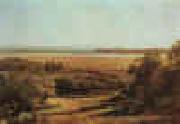 |
Worthington Whittredge -- Click Here
|
|
1820-1910
Thomas Worthington Whittredge (May 22, 1820 - February 25, 1910) was an American artist of the Hudson River School. Whittredge was a highly regarded artist of his time, and was friends with several leading Hudson River School artists including Albert Bierstadt and Sanford Robinson Gifford. He traveled widely and excelled at landscape painting, many examples of which are now in major museums. He served as president of the National Academy of Design from 1874 to 1875 and was a member of the selection committees for the 1876 Philadelphia Centennial Exposition and the 1878 Paris Exposition, both important venues for artists of the day.
Whittredge was born in a log cabin near Springfield, Ohio in 1820. He painted landscapes and portraits as a young man in Cincinnati before traveling to Europe in 1849 to further his artistic training. Arriving in Germany he settled at the Dusseldorf Academy, a major art school of the period, and studied with Emanuel Leutze. At Dusseldorf, Whittredge befriended Bierstadt and posed for Leutze as both George Washington and a steersman in Leutze??s famous painting ??Washington Crossing the Delaware??, now in the collection of the Metropolitan Museum of Art in New York City.
Whittredge spent nearly ten years in Europe, meeting and travelling with other important artists including Sanford Gifford. He returned to the United States in 1859 and settled in New York City where he launched his career as a landscape artist painting in the Hudson River School style.
Whittredge journeyed across the Great Plains to the Rocky Mountains in 1865 with Sanford Gifford and John Frederick Kensett. The trip resulted in some of Whittredge??s most important works??unusually oblong, spare landscapes that captured the stark beauty and linear horizon of the Plains. Whittredge later wrote in his autobiography, ??I had never seen the plains or anything like them. They impressed me deeply. I cared more for them than for the mountains... Whoever crossed the plains at that period, not withstanding its herds of buffalo and flocks of antelope, its wild horses, deer and fleet rabbits, could hardly fail to be impressed with its vastness and silence and the appearance everywhere of an innocent, primitive existence."
Whittredge moved to Summit, New Jersey, in 1880 where he continued to paint for the rest of his life. He died in 1910 at the age of 89 and is buried in the Springfield, New Jersey cemetery. Whittredge's paintings are now in the collections of numerous museums, including the Metropolitan Museum of Art in New York City and the Smithsonian American Art Museum in Washington, DC. |
|
|
|
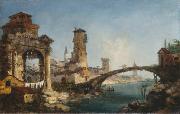 |
Workshop of Michele Marieschi -- Click Here
|
|
painted Fantastic landscape with ruins in 1730s
|
|
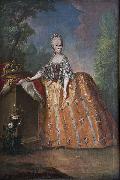 |
Workshop of Anton von Maron -- Click Here
|
|
Anton von Maron (January 8, 1733 - March 3, 1808) was an Austrian painter, active in Rome.
Von Maron was born in Vienna, but moved at a young age to Rome. There, he studied under Anton Raphael Mengs, and became an accomplished portrait painter. He married a sister of Mengs, Therese Maron, who was a painter in her own right. He lived the rest of his life in Rome, and died there in 1808. |
|
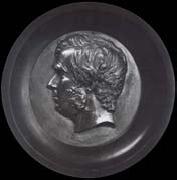 |
Woolner, Thomas -- Click Here
|
|
1825 - 1892,English sculptor and poet. He ranks with John Henry Foley as the leading sculptor of mid-Victorian England. He trained with William Behnes and in 1842 enrolled as a student at the Royal Academy, London. In 1844 he exhibited at Westminster Hall, London, a life-size plaster group, the Death of Boadicea (destr.), in an unsuccessful attempt to obtain sculptural commissions for the Houses of Parliament. His earliest important surviving work is the statuette of Puck (plaster, 1845-7; C. G. Woolner priv. col.), which was admired by William Holman Hunt and helped to secure Woolner's admission in 1848 to the Pre-Raphaelite Brotherhood. The work's Shakespearean theme and lifelike execution, stressing Puck's humorous malice rather than traditional ideal beauty, made it highly appealing. Although eclipsed by Hunt, John Everett Millais and Dante Gabriel Rossetti, Woolner was an important figure in the Brotherhood. He contributed poetry to its journal, The Germ (1850), and his work was committed to truthfulness to nature more consistently than that of any other Pre-Raphaelite, except for Hunt. This is evident in Woolner's monument to William Wordsworth (marble, 1851; St Oswald, Grasmere, Cumbria). |
|
|
|
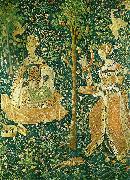 |
woman embroidering -- Click Here
|
|
sixteenth century
courtly life tapestry
paris
musee de cluny |
|
 |
Wolfgang Heimbach -- Click Here
|
|
c.1600/1615-after 1678, German painter. The son of a bookkeeper at the corn exchange, he was known because of a disability as 'the Ovelg?nne mute'. An aristocratic sponsor, probably Graf Anton G?nther (1603-67) of Oldenburg, sent him to train in the Netherlands: stylistic considerations would suggest that this was in the 1630s. The Evening Scene (1637; ex-art market, Berlin; G?ttsche, no. 8) shows him adapting the style of Caravaggio as practised in Utrecht to the kind of social gathering depicted by Dirck Hals or Anthonie Palamedesz. He uses an artificial light source to exaggerate the modelling of the figures and the space. This characteristic of his art also shows in the Evening Banquet of 1640 |
|
 |
wolfgang amadeus mozart -- Click Here
|
|
Born: 27 January 1756
Birthplace: Salzburg, Austria
Died: 5 December 1791 (fever)
Best Known As: Composer of Eine kleine Nachtmusik |
|
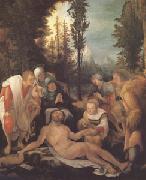 |
Wolf Huber -- Click Here
|
|
Feldkirch ca 1480-Passau 1553 |
|
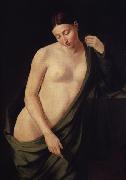 |
Wojciech Stattler -- Click Here
|
|
(1800, Krakew - 1875) was a Polish painter of Swiss aristocratic ancestry and a long-standing professor of the School of Fine Arts in Krakew.
|
|
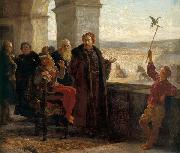 |
Wojciech Gerson -- Click Here
|
|
(1831 - 1901) was a Polish painter and professor.
Born in Warsaw, Gerson enrolled at the Warsaw Fine Arts Academy and graduated with honorable mention and a scholarship to St. Petersburg Academy of Arts where he studied historical painting under A. T. Markov. He graduated from St. Petersburg with a silver medal and returned to Warsaw. He left for Paris in 1850 and studied under Leon Cogniet.
He travelled back to Warsaw in 1858, where he would live for the rest of his life. Gerson began to teach art in his own workshop in 1865. He trained many future Polish artists such as J??zef Chełmo??ski, Leon Wycz??łkowski, Władysław Podkowi??ski, and J??zef Pankiewicz. He was made a professor for the St. Petersburg Fine Arts Academy in 1878.
Gerson also worked as an architect and art critic. He is known for his paintings of patriotism, country life, and mountain landscapes. Gerson died in Warsaw, aged 70. |
|
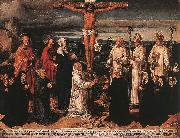 |
WOENSAM VON WORMS, Anton -- Click Here
|
|
before 1500 - before 1541 in Cologne |
|
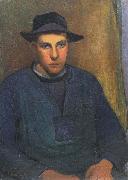 |
Wladyslaw slewinski -- Click Here
|
|
(1854-1918) was a Polish painter. He was a student of Gauguin's and a leading artist of the Young Poland movement.
Władysław Ślewiski was a Polish painter. He administered his estate in Poland before traveling to Paris in 1888. Once there he studied at the Academie Colarossi where he met Gauguin. The impression this encounter made on him and Gauguin's encouragement prompted Slewinski to dedicate himself to art. He submitted to Gauguin's artistic and personal influence, spending time with him in Paris and, from 1889, in Pont-Aven and Le Pouldu in Brittany.
Seascapes painted during this period include Cliffs in Brittany. In 1891 Gauguin painted a portrait of Slewinski and presented it to him. During this period Slewinski exhibited in Paris, with some success, both at the Salon des Independents in 1895 and 1896 and the Galerie Georges Thomas in 1897 and 1898.
|
|
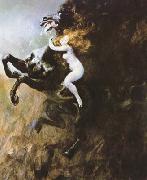 |
Wladyslaw Podkowinski -- Click Here
|
|
Polish Painter, 1866-1895
Polish painter and illustrator. In 1880-84 he studied in Warsaw at Wojciech Gerson's Drawing School. From 1884 he regularly contributed illustrations to leading Warsaw journals such as Tygodnik Ilustrowany and Wedrowiec. In 1885, accompanied by his fellow artist J?zef Pankiewicz, he went to St Petersburg and studied (1885-6) at the Academy of Fine Arts. Disappointed with the conservative teaching system and short of money, he returned to Warsaw in 1886 and in 1887 continued working regularly for Tygodnik Ilustrowany, becoming one of its most popular illustrators. He produced his first watercolours and oil paintings, much under the influence of Aleksander Gierymski, but continued to regard these as secondary activities until a stay in Paris in 1889, again in the company of Pankiewicz. Here, the experience of new French painting, especially that of Claude Monet shown at the Galerie Georges Petit, encouraged Podkowinski to attempt paintings in an Impressionist manner. |
|
|
|
Wladyslaw Malecki -- Click Here
|
|
(1836 in Maslew - 1900 in Szydłowiec) was a Polish painter.
|
|
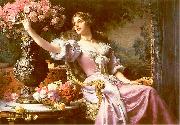 |
Wladyslaw Czachorski -- Click Here
|
|
(1850-1911) was a Polish artist.
In 1866 Czachorski went to the Warsaw Drawing School and had Rafał Hadziewicz as a peer. Then he spent one year at the Dresden Academy and from there went to Munich Academy (1869-1873) some of his classmates were: Hermann Anschetz, Karl von Piloty, and Alexander Wagner. He received Magna Cum Laude (the Grand Silver Medal) from Munich, and proceeded to travel to France, Italy and Poland after his graduation. He held membership to Berlin academy and has also organizer and jurist of international exhibitions even though he had his home in Munich. He was awarded the Bavarian Order of Saint Michael in 1893. He had many art exhibitions in Poland. Some took place in Krakew, Warsaw, Łedź, and Lwew. After his death in 1911, a posthumous showing was held at the Warsaw "Zachęta" Society of Fine Arts.
Some of Czachorski's noted works were: still lifes, painted portraits, and Shakespearean scenes. Some of these that he painted were: Julliette's Funeral (1873), Hamlet (1873), and, most notably, Hamlet Receiving the Players (1875); widely recognized as his greatest works.
His paintings can be found in all the more famous and sizable museums of Poland. His works also make appearances in private collections in many countries including: Germany, Poland, England and the United States. They can also be found in foreign museums such as Lwew, Bremen and the Academia de San Carlos in Mexico City.
|
|
 |
Wladislaw Podkowinski -- Click Here
|
|
Polish Painter, 1866-1895 |
|
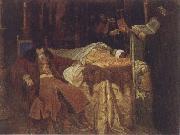 |
Wjatscheslaw Grigorjewitsch Schwarz -- Click Here
|
|
1834-1869
Realism,Russian
|
|
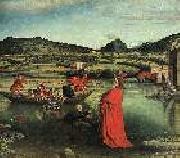 |
WITZ, Konrad -- Click Here
|
|
b. cca 1400, Rottweil, d. ca. 1445, Basel. German-born painter from Rottweil in Swabia, active in Switzerland. German painter. One of the great innovators in northern European painting, he turned away from the lyricism of the preceding generation of German painters. His sturdy, monumental figures give a strong impression of their physical presence, gestures are dignified and the colours strong and simple. Even scenes with several figures are strangely undramatic and static. The surface appearance of materials, especially metals and stone, is intensely observed and recorded with an almost naive precision. Powerful cast shadows help to define the spatial relationships between objects. His fresh approach to the natural world reflects that of the Netherlandish painters: the Master of Fl?malle and the van Eycks. He need not, however, have trained in the Netherlands or in Burgundy as knowledge of their style could have been gained in Basle. He remained, however, untouched by the anecdotal quality present in their art, |
|
 |
WITTEL, Caspar Andriaans van -- Click Here
|
|
Dutch Baroque Era Painter, ca.1653-1736 |
|
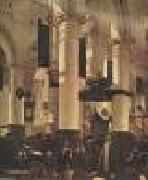 |
WITTE, Emanuel de -- Click Here
|
|
Dutch Baroque Era Painter, ca.1617-1691
Dutch painter. He was one of the last and, with Pieter Saenredam, one of the most accomplished 17th-century artists who specialized in representing church interiors. He trained with Evert van Aelst (1602-57) in Delft and in 1636 joined the Guild of St Luke at Alkmaar, but he was recorded in Rotterdam in the summers of 1639 and 1640. In October 1641 his daughter was baptized in Delft, where he entered the Guild of St Luke in June 1642 and lived for a decade, moving to Amsterdam c. 1652. He began his long career as an unpromising figure painter, as can be seen in the Vertumnus and Pomona (1644) and two small pendant portraits (1648; all Rotterdam, Mus. Boymans-van Beuningen). Jupiter and Mercury in the House of Philemon and Baucis (1647) and a Rembrandtesque Holy Family |
|
 |
Witold Pruszkowski -- Click Here
|
|
Polish Painter, 1846-1896
Polish painter and draughtsman. He spent his early years in Odessa and Kiev, subsequently living in France, in particular in Paris, where he studied under the Polish portrait painter Tadeusz Gorecki (1825-68), continuing (1868-71) at the Akademie der Kenste in Munich. In 1871 he moved to Krakew where he studied until 1875 under Jan Matejko at the School of Fine Arts. During ten years in Krakew he produced many striking portraits. In the portrait of Mrs Fedorowicz (1878; Krakew, N. Mus.) he achieved subtle effects of modelling by means of carefully differentiated tones and meticulously distributed light. The Realism of these portraits is subsumed into an advanced proto-Impressionist technique, on occasion using both small patches of distinct colour and broadly applied areas of impasto. Alongside such works, Pruszkowski produced paintings based on fantastic legends, fables and folk-tales. In these works one can trace influences going back to the artist's Munich period; but Pruszkowski's essentially Romantic vision translated his subjects into an entirely Polish context, as in Midsummer's Night (1875; Warsaw, N. Mus.) and Water Nymphs (1877; Krakew, N. Mus.). In 1882 Pruszkowski moved to the village of Mnikow outside Krakew, where he worked in the isolation he believed essential for creative activity. Contact with the country people, however, provided him with themes for his work; alongside his fantastic and legendary subjects he painted genre scenes of peasant life. He brought to his subjects a diversity of means of formal depiction, from the realistic to the near visionary. However, there are notable recurrent motifs, for example the image of the native willow, the symbolic haunt of spirits, as in Willow on Marshland (1892; Ledz, Mus. A.). The visionary element achieved its apogee in the pastel compositions from the last years of his life. In works such as Death of Ellenai (1892; Wroclaw, N. Mus.) the evanescent nature of forms is expressed through restrained colour schemes, generally tending towards silvery greyish azure or shades of pink. |
|
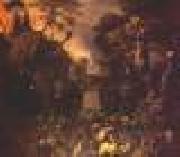 |
WITHOOS, Mathias -- Click Here
|
|
Dutch painter (b. 1627, Amersfoort, d. 1703, Hoorn). |
|
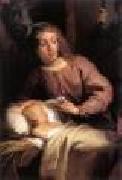 |
WIT, Jacob de -- Click Here
|
|
Dutch Rococo Era Painter, 1695-1754
Dutch painter, draughtsman, etcher and writer. He was the leading 18th-century Dutch decorative painter, specializing in Rococo ceiling and room decorations and groups of putti painted naturalistically in colour or as imitation reliefs in grisaille. His preparatory drawings for ceiling decorations were collected during his own lifetime, but he also executed independent finished drawings specifically for collectors |
|
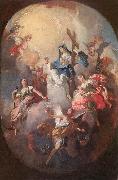 |
WINTERHALTER, Josef the Younger -- Click Here
|
|
German painter (b. 1743, Vöhrenbach, d. 1807,
Znojmo). |
|
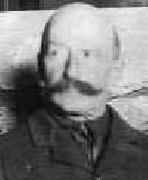 |
Winslow Homer -- Click Here
|
|
1836-1910
Winslow Homer Locations
Winslow Homer (February 24, 1836 ?C September 29, 1910) was an American landscape painter and printmaker, best known for his marine subjects. He is considered one of the foremost painters in 19th century America and a preeminent figure in American art.
Largely self-taught, Homer began his career working as a commercial illustrator. He subsequently took up oil painting and produced major studio works characterized by the weight and density he exploited from the medium. He also worked extensively in watercolor, creating a fluid and prolific oeuvre, primarily chronicling his working vacations. |
|
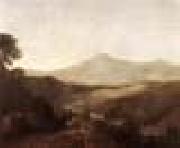 |
WILSON, Richard -- Click Here
|
|
Welsh Romantic Painter, ca.1713-1782
British landscape painter, b. Wales. He studied in London and achieved success as a portrait painter, but after a visit to Italy (c.1750?C1756) he devoted himself to landscape in the classical tradition of Claude Lorrain. The exhibition of Wilson's Niobe in 1760 won him acclaim, and he was made a member and later librarian of the Royal Academy. His work did not become generally popular until after his death. Although his Italian landscapes did not depart from the classical tradition of picturesque Roman ruins and recumbent nymphs, his work shows considerable originality and breadth of treatment, especially in his many fine paintings of English country houses. He exerted a strong influence on subsequent landscape painting in England. On Hounslow Heath (National Gall., London) and Afternoon and Lake Nemi |
|
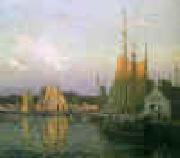 |
Wilson Irvine -- Click Here
|
|
1869-1936
Wilson Henry Irvine Galleries
Wilson Henry Irvine (28 February 1869-1936) was a master American Impressionist landscape painter. Although most closely associated with the Old Lyme, Connecticut art colony headed by Florence Griswold, Irvine spent his early career near Chicago, a product of the School of the Art Institute of Chicago. Irvine also painted across Western Europe ?? where he produced outstanding American Impressionist versions of the local countryside.
Today, Wilson Irvine's paintings grace the collection of Chicago's Art Institute, as well as other notable collections strong in American Impressionism, including: Old Lyme's Florence Griswold Museum; Washington, D.C.'s Smithsonian Institution National Portrait Gallery and Corcoran Gallery of Art; and Chicago's Union League Club.
Irvine is best known for his mastery of light and texture ?? a 1998 exhibit of his work was called Wilson Henry Irvine and the Poetry of Light. To capture subtle effects of light, Irvine often painted en plein air ?? wearing his trademark cap, knickers, and goatee, with his easel and his paints set up in the field.
Sometimes Irvine's obsession with light led him to paint rather pedestrian subjects ?? landscapes depicting little more than some trees, or a road or fence. But a number of Irvine masterpieces depict well-composed scenes including houses, boats, bridges ?? even a handful of portraits, including at least one self-portrait and a nude.
Wilson Henry Irvine, born near Byron, Illinois, was a descendant of early Illinois settlers and farmers. Wilson channeled his family's agrarian interests into a painter's eye for landscape.
From the beginning, Irvine's interest in painterly subjects was equalled by a parallel focus on artistic technology. While still in his 20s, Irvine was a pioneer of the airbrush as artistic medium ?? a medium which had just been developed and marketed by Liberty Walkup, Irvine's Illinois neighbor, mentor, and teacher.
Having mastered the airbrush, in 1888 Irvine moved to Chicago to make his reputation. Irvine's "day job" during this period was as an illustrator/graphic designer, often employing the still-novel airbrush. But simultaneously, Irvine built a career as a serious painter. He worked his way up Chicago art society ?? he led the Palette and Chisel Club and Cliff Dwellers Club, along with sculptor Loredo Taft.
During these years, Irvine gravitated to the night school of the famed Art Institute of Chicago, where he studied for over seven years. Indeed, the Art Institute was to remain a loyal patron. By the turn of the century, the Institute often showed Irvine's work, and gave him a prestigious solo show over the 1916-1917 Christmas season. To this day, the Art Institute maintains a number of Wilson Irvine paintings in its permanent collection. |
|
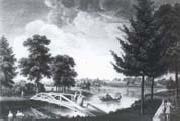 |
Wiloliam Woollett -- Click Here
|
|
British, 1735-1785 |
|
|
|
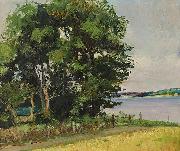 |
Willy Baron von Plessen -- Click Here
|
|
(1712 - 1777) |
|
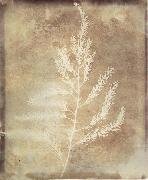 |
Willim Henry Fox Talbot -- Click Here
|
|
British, 1800-1877
|
|
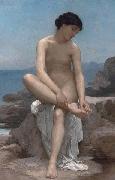 |
William-Adolphe Bouguereau -- Click Here
|
|
(November 30, 1825 - August 19, 1905) was a French academic painter. William Bouguereau was a traditionalist whose realistic genre paintings and mythological themes were modern interpretations of Classical subjects with a heavy emphasis on the female human body.
William-Adolphe Bouguereau was born in La Rochelle, France on November 30, 1825, into a family of wine and olive oil merchants. He seemed destined to join the family business but for the intervention of his uncle Eugene, a Roman Catholic priest, who taught him classical and Biblical subjects, and arranged for Bouguereau to go to high school. Bouguereau showed artistic talent early on and his father was convinced by a client to send him to the École des Beaux-Arts in Bordeaux, where he won first prize in figure painting for a depiction of Saint Roch. To earn extra money, he designed labels for jams and preserves |
|
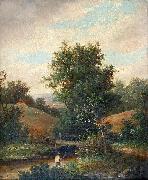 |
William Yates -- Click Here
|
|
painted Fisherman on the River Bank in 19th Century
|
|
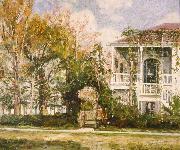 |
William Woodward -- Click Here
|
|
(1 May 1859 - 17 November 1939) was a U.S. artist and educator, best known for his impressionist paintings of New Orleans and the Gulf Coast of the United States.
Woodward was born in Seekonk, Massachusetts. His younger brother Ellsworth Woodward also became a notable artist. William Woodward studied art at the Rhode Island School of Design, and later at the Academie Julian where he received instruction from Gustave Boulanger and Jules Lefebvre.
View of the Napoleon House in New Orleans, 1904In 1884 Woodward was hired to teach fine art, mechanical drawing, and architectural drawing at Tulane University in New Orleans. He became interested in the history and architecture of the city, especially the old French Quarter, which at the time had become largely neglected with many of the historic structures in a state of decay. In 1895 he led a successful campaign to save the Cabildo from demolition. His series of paintings of French Quarter scenes helped shape awareness of the neighborhood's architectural heritage and spurred the formation of the Vieux Carre Commission to help preserve it.
He started teaching architectural engineering at Tulane in 1894 and helped found the Tulane School of Architecture in 1907, as well as the Newcomb School of Art.
In 1921 he suffered an accident and used a wheelchair for the rest of his life. He retired from Tulane the following year, and in 1923 moved to Biloxi, Mississippi. He invented the fiberloid dry etching process. He continued to paint and produce etchings for the rest of his life.
|
|
|
|
william witherington -- Click Here
|
|
William Frederick Witherington (26 May 1785 - 10 April 1865) was an English painter and academic. Born in London, he entered the Royal Academy Schools in 1805. Except for one year he exhibited annually at the Royal Academy from 1811 until his death. He was elected A.R.A. on 1 November 1830 and R.A. on 10 February 1840. He retired as an academician on 28th May 1863.
His early works were mostly landscapes, but the influence of artists like George Morland (1763 - 1804) can be seen in the importance he gave to the figurative element in his paintings.
Witherington enjoyed painting English scenery and never travelled abroad. As with many of his works, he does not depict the harsh realities of rural life, but instead records incidents of family life. Like his contemporary, Augustus Wall Callcott, RA, he creates a composition with a lively foreground of figures and animals, combined with a landscape with distant vistas glimpsed through the wood. |
|
 |
William Williams -- Click Here
|
|
English-born American Colonial Era Painter, 1727-1791
was an American painter. He was born in Caerphilly, Wales. He began residing in Philadelphia around 1747 and afterwards in New York City before returning to England about 1780, where he died in Bristol |
|
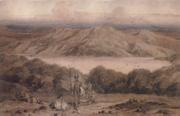 |
William Westall -- Click Here
|
|
English painter and engraver
1781-1850
was an English artist who travelled aboard HMS Investigator on her voyage to Australia. Westall was born in Hertford, England. Westall, like the other botanical artist on HMS Investigator Ferdinand Bauer, was born into an artistic family. His older half brother Richard, was a member of the Royal Academy, and assisted him in securing a place for his younger half brother at the Royal Academy in 1799. During his studies at the Royal Academy Westall's work came to the attention of Joseph Banks, who was at the time keen to find a landscape artist for Matthew Flinders' expedition aboard HMS Investigator. With the support of Banks, Westall was appointed by the Admiralty in London as landscape and topographical artist on HMS Investigator. In 1801, at the age of 19, Westall found himself aboard HMS Investigator. The subsequent voyage of discovery to Terra Australise, has in time come to be regarded as one of the notable scientific and botanical studies ever undertaken. William Westall, King George's Sound in Albany, Western AustraliaWestall began sketching the Australian coast, south of Cape Leeuwin and later on Monday 7 December 1801, King George's Sound, Western Australia, thereby becoming one of the first professional artists to draw the Australian landscape painting. Many of the sketches that Westall created were coastal profiles, to assist with the important task of mapping Australian coastline. The subsequent circumnavigation of Australia took Westall from Cape Leeuwin in Western Australia, across the Great Australian Bight to the South Australian gulf country, to Kangaroo Island, and thence to Port Jackson and the Gulf of Carpentaria. Particularly notable amongst the works created by Westall during the voyage are his accurate portraits of Aboriginal people and the watercolours of their cave paintings, the first European artist to depict the cave paintings. |
|
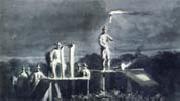 |
William Waud -- Click Here
|
|
An architect .
British-American , ca.1830-1878
|
|
 |
William Vincent Cahill -- Click Here
|
|
American, died 1924 |
|
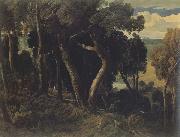 |
William Turner of Oxford -- Click Here
|
|
British, 1789-1862
He probably received his earliest training from William Delamotte, in Oxford. In 1804 he went to London and became a pupil of John Varley, possibly being formally apprenticed. He first exhibited at the Royal Academy in 1807; in January 1808 he was elected an associate of the Society of Painters in Water-Colours, and in November of that year became its youngest full member. He exhibited there annually from 1808 until his death, sending 455 works in all. His passionate, technically complex youthful work was highly acclaimed, yet its promise remained unfulfilled; around 1811 he returned to Oxfordshire and soon established himself as a drawing-master in Oxford. |
|
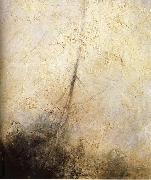 |
William Turner -- Click Here
|
|
English Romantic Painter, 1775-1851
British painter and printmaker. He dominated British landscape painting throughout the first half of the 19th century. He established a reputation in the Royal Academy, London, first as a topographical watercolourist and then within a few years as a painter of Sublime and historical landscapes. |
|
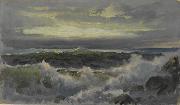 |
William Trost Richards -- Click Here
|
|
(June 3, 1833 - April 17, 1905) was an American landscape artist associated with both the Hudson River School and the American Pre-Raphaelite movement.
William Trost Richards was born on 3 June 1833 in Philadelphia. In 1846 and 1847 he attended the local Central High School. Between 1850 and 1855 he studied part-time with the German artist Paul Weber while working as designer and illustrator of ornamental metalwork. Richards first public showing was part of an exhibition in New Bedford, Massachusetts, organized by artist Albert Bierstadt in 1858. In 1862 he was elected honorary member of the National Academy of Design and Academician in 1871. In 1863, he became a member of the Association of the Advanced of Truth in Art, an American Pre-Raphaelite group. In 1866, he departed for Europe for one year. Upon his return and for the following six years he spent the summers on the East Coast. In the 1870s, he produced many acclaimed watercolor views of the White Mountains, several of which are now in the collection of the Metropolitan Museum of Art. Richards exhibited at the National Academy of Design from 1861 to 1899 and at the Brooklyn Art Association from 1863 to 1885. He was elected a full member of the National Academy in 1871.
Richards rejected the romanticized and stylized approach of other Hudson River painters and instead insisted on meticulous factual renderings. His views of the White Mountains are almost photographic in their realism. In later years, Richards painted almost exclusively marine watercolors.
His works are featured today in many important American museums, including the National Gallery, the Smithsonian American Art Museum, the Wadsworth Atheneum, the Philadelphia Museum of Art, the Yale University Art Gallery, the High Museum of Art, the Museum of Fine Arts, Boston, the Fogg Art Museum, the Brooklyn Museum of Art and the Thyssen-Bornemisza Museum.
|
|
|
|
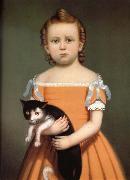 |
William Thompson Bartoll -- Click Here
|
|
American, 1817-1857 |
|
 |
William Strutt -- Click Here
|
|
English Painter, ca.1825-1915
was an English artist. Strutt was born in Teignmouth, Devon, England, and came from a family of artists, his grandfather, Joseph Strutt, was a well-known author and artist, his father, William Thomas Strutt, was a good miniature painter. William Strutt enjoyed a student life in Paris, France, and England, studying figurative and history painting. In response to a near-breakdown and problems with his eyes, Strutt decided to visit Australia, arriving 5 July 1850 on the Culloden, where he then married. In Melbourne, Strutt found employment as an illustrator on the short-lived Illustrated Australian Magazine, published by Thomas Ham, as there was little demand for the figurative and history paintings for which he was trained. Some of his designs did, however, lead to commissions, including a design for a new postage stamp, and an Anti-Transportation League card. Despite the lack of interest for major history paintings in Melbourne, Strutt continued to sketch suitable subjects, including the "Black Thursday" bushfires, which swept over the colony on 6 February 1851. It was from these sketches that Strutt composed one of his most notable paintings some 10 years later, Black Thursday, February 6th. 1851, 1864, which depicted animals and men fleeing from the fire. In February 1852, Strutt joined the growing tide of men travelling to the gold-fields surrounding Ballarat, Victoria. Despite working in the gold fields for eighteen months he found little success. He returned to Melbourne in mid-1853 and became actively involved in the city's cultural scene, undertaking a number of portrait commissions and joining the Victorian Society of Fine Arts as a founding member. William Strutt, Portrait of John Pascoe Fawkner, founder of Melbourne, 1856: oil on canvas; 61.3 x 51.2 cm. National Library of Australia.Strutt's interest in depicting the notable events of the colony was piqued by the events surrounding the Victorian Exploring Expedition led by Burke and Wills in 1860-61. He made several studies of their preparations at Royal Park, Melbourne, and followed the expedition to its first camp at Essendon, Victoria. Strutt also collected first-hand accounts from the rescue party and from John King, |
|
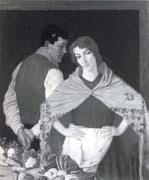 |
William Strang -- Click Here
|
|
British Painter, 1859-1921,Scottish painter and printmaker. Following a brief apprenticeship with a shipbuilding firm in Clydesdale, he entered the Slade School of Art (1876) where he adhered to the uncompromising realism advocated by his teacher Alphonse Legros. After completing his studies at the Slade (1880), Strang became Legros's assistant in the printmaking class for a year. For the next 20 years he worked primarily as an etcher. His etchings include landscapes in the tradition of Rembrandt, pastoral themes indebted to Giorgione and macabre genre subjects, marked by a sense of tension and suspended animation. He also etched 150 portraits of leading artistic and literary figures. The commitment to realism and psychological intensity that characterizes the best of Strang's etched work is also evident in the paintings that dominated the latter half of his career. The influence of the Belgian and French Symbolists' work and Strang's growing confidence in the handling of colour combined in his mature style with a linear clarity and schematic colouring that is best seen in such works as Bank Holiday (1912; London, Tate). His oil portraits, for example Vita Sackville-West as Lady In a Red Hat (1918; Glasgow, A.G. & Mus.), are strikingly potent images of their time. An important collection of Strang's graphic work is in the Art Gallery and Museum in Glasgow. |
|
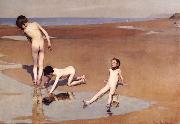 |
William Stott of Oldham -- Click Here
|
|
British , 1857-1900 |
|
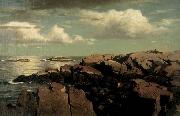 |
William Stanley Haseltine -- Click Here
|
|
(June 11, 1835-February 3, 1900) was an American painter and draftsman who was associated with the Hudson River School and Luminism.
Born in Philadelphia to John Haseltine, a successful businessman, and Elizabeth Shinn Haseltine, an amateur landscape painter, Haseltine studied at the University of Pennsylvania and then at Harvard University, where he received a degree in 1854.
He first exhibited his paintings the following year at the Pennsylvania Academy of Fine Arts, after which he sailed to Europe, first joining a colony of American painters who were studying in Dusseldorf, then traveling up the Rhine into Switzerland and Italy. In late 1857 he settled in Rome, and in the following months made numerous excursions to draw the landscape around Rome and on Capri.
In 1858 Haseltine returned to Philadelphia, and by late 1859 was installed in the Tenth Street Studio Building in New York City, then a central point for American landscape painters; also in the building were Frederic Edwin Church, Albert Bierstadt, and Worthington Whittredge, the latter two having befriended Haseltine in Europe. Though many of his paintings from this time derived from his European sketches, Haseltine also began to paint the oceanside of New England, especially favoring the rockbound coasts of Narragansett, Rhode Island, Nahant, Massachusetts, and Mount Desert Island, Maine. The precision with which he painted these landscapes won critical praise, and Haseltine was elected an Associate of the National Academy of Design in 1860, and a full Academician in 1861.
In 1864 Haseltine's wife died in childbirth. He spent some time training his nephew, Howard Russell Butler, but he moved after he married Helen Marshall in 1866. Initially the family considered settling in Paris, but in 1867 they moved to Rome, which would for most of Haseltine's subsequent years serve as his home and point of departure from which to produce views of the European landscape. While his paintings of Capri and Sicily would prove popular with visiting American tourists, Haseltine also traveled and drew in France, Holland, Belgium, and the Netherlands, summering in Bavaria and the Tyrol in the 1880s and 1890s. In his later years he also returned periodically to the United States, making a final trip to the west in 1899.
Haseltine died of pneumonia in Rome in 1900. |
|
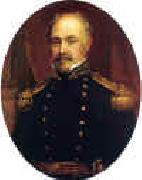 |
William Smith Jewett -- Click Here
|
|
1789-1874
William Smith Jewett Galleries |
|
|
|
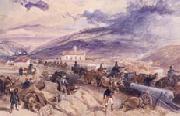 |
William Simpson -- Click Here
|
|
British Painter (1823-1899)
was a British artist and war correspondent. Born into poverty in Glasgow on 28 October 1823, Simpson went on to become one of the leading 'special artists' of his day, and sketched many scenes of war for the Illustrated London News. His early years were very difficult living in a house with an abusive and alcoholic father, and in 1834 he was sent to live with his grandmother in Perth. Simpson's only formal schooling took place during this period and within a few years, he was working as an apprentice in the Glasgow lithographic firm of Macfarlane. The artist stated later that "this was the turning point which changed all my boyish intentions." It was during the years in Glasgow that he attended the Andersonian University and the Mechanics Institute in the evenings. His next position was with the lithographic company of Allan and Ferguson where he spent four years learning the trade. In 1851 Simpson moved to London where he was hired by Day & Sons. While at Day's he was able to work on several important lithographic sets. He became famous initially for his work in the Crimean War where he was sent by the firm of Colnaghi to create a series of watercolors suitable for lithographing. In the late 1850's he was sent to India to sketch scenes relating to the recent Sepoy Revolt. He joined the ILN in 1866 and covered the Abyssinian Campaign of 1868. In 1870 he went to France to sketch the war with Prussia, and in the following year observed the barricades of the Paris Commune. During a trip around the world, he stopped off in California and traveled to the Lava Beds area to report on the Modoc War in 1873. Five years later, he journeyed to Afghanistan to provide illustrations of the Second Afghan War that had broken out; he returned to London in the summer of 1879. In 1890, he observed the opening of the Forth Bridge and caught a chill which was to have detrimental effects on his health. He died at home in Willesden, north London, on August 17, 1899, and was buried in Highgate Cemetery. Besides his war pictures, he covered state events, coronations, funerals, and other ceremonies. He was particularly interested in India and sketched scenes of the Kashmir Maharajas. |
|
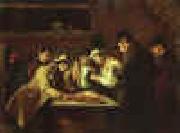 |
William Sidney Mount -- Click Here
|
|
1807-1868
William Sidney Mount Galleries
William Sidney Mount (November 26, 1807 ?C November 19, 1868) born in Setauket, New York was a renowned genre painter and contemporary of the Hudson River School. Mount trained at the National Academy of Design in New York. Two of his more famous paintings are Eel Spearing at Setauket (1845, New York State Historical Association, Cooperstown) and Bargaining for a Horse (1835, New-York Historical Society, New York City). Beginning as a history painter, Mount moved to depicting scenes from everyday life. The largest collection of his works is located in The Long Island Museum of American Art, History, and Carriages
His home and studio, the William Sidney Mount House, is a National Historic Landmark. One of the local elementary schools in The Three Village Central School District is named in his honor, as is PS 174 elementary school in Rego Park, Queens. A residential building is named after him on the Stony Brook University campus. |
|
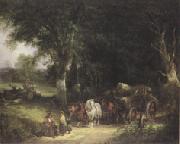 |
William Shayer -- Click Here
|
|
1787-1879
English painter. Although based in Southampton and catering predominantly to a provincial market, he also exhibited in London. Between 1825 and 1870 he showed over 330 works at the Royal Society of British Artists and 80 at the British Institution. Shayer produced rural genre scenes in the manner of Francis Wheatley, Julius Caesar Ibbetson and, predominantly, |
|
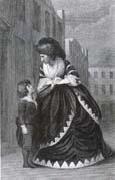 |
William Sharp -- Click Here
|
|
British 1749-1824,was an English line-engraver born in London. He was originally apprenticed to what is called a bright engraver, and practised as a writing engraver, but gradually became inspired by the higher branches of the engraver's art. Among his earlier plates are some illustrations, after Stothard, for the Novelists' Magazine. He engraved the "Doctors Disputing on the Immaculateness of the Virgin" and the "Ecce Homo" of Guido Reni, the "St Cecilia" of Domenichino, the "Virgin and Child" of Dolci, and the portrait of John Hunter of Sir Joshua Reynolds. His style of eta-graving is thoroughly masterly and original, excellent in its play of line and rendering of half-tints and of "colour." He died at Chiswick on the 25th of July 1824. In his youth, owing to his hotly expressed adherence to the politics of Paine and Horne Tooke, he was examined by the privy council on a charge of treason. Mesmer and Brothers found in Sharp a stanch believer; and for long he maintained Joanna Southcott at his own expense. As an engraver he achieved a European reputation, and at the time of his death he enjoyed the honour of being a member of the Imperial Academy of Vienna and of the Royal Academy of Munich. |
|
 |
william shakespeare -- Click Here
|
|
Born: 23 April 1564
Birthplace: Stratford-upon-Avon, England
Died: 23 April 1616
Best Known As: The famed author of Romeo and Juliet |
|
|
|
 |
William Scrots -- Click Here
|
|
William (or Guillim) Scrots (or Scrotes or Stretes) (active 1537-1553) was a painter of the Tudor court and an exponent of the Mannerist style of painting in the Netherlands. He is first heard of when appointed a court painter to Mary of Habsburg, Regent of the Netherlands, in 1537. In England, he followed Hans Holbein as King's Painter to Henry VIII in 1546, with a substantial annual salary of £62 10s, over twice as much as Holbein's thirty pounds a year. He continued in this role during the reign of the boy king Edward VI. His salary was stopped on Edward's death in 1553, after which it is not known what became of him, though it is presumed he left England.
Edward VI, attributed to Scrots, Hampton Court.
Portrait of Edward VI in distorted perspective, 1546.Little more is known of Scrots than that his paintings showed an interest in ingenious techniques and detailed accessories. Scrots was paid 50 marks in 1551 for three "great tables", two of which were portraits of Edward delivered to the ambassadors Thomas Hoby and John Mason as gifts for foreign monarchs, and the third a "picture of the late earle of Surrey attainted." Two full-length portraits of Edward VI in a pose similar to that of Holbein's portrait of his father, one now in the Royal Collection (left) and another now in the Louvre (below), are attributed to Scrots and are likely to be these two paintings. Scrots also painted an anamorphic profile of Edward VI, distorted so that it is impossible to view it normally except from a special angle to the side. This optical trick is similar to that used by Holbein in his painting The Ambassadors and in contemporary portraits of Francis I and Ferdinand I. Later, when the painting was exhibited at Whitehall Palace in the winter of 1591-92, it created a sensation, and important visitors were all taken to see it. |
|
|
|
 |
William Sawrey Gilpin -- Click Here
|
|
William Sawrey Gilpin (1762-1843) |
|
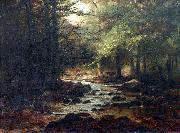 |
William Samuel Horton -- Click Here
|
|
painted Landscape with Stream in c. 1900
|
|
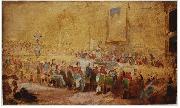 |
William Salter -- Click Here
|
|
painted Sketch of the 1836 Waterloo Banqet by William Salter in 1836 |
|
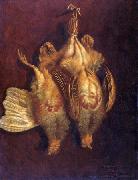 |
William Roos -- Click Here
|
|
William Roos (1808 - 4 July 1878) was a Welsh artist and engraver. Several of Roos' portraits, mainly of notable Welsh figures, are owned by the National Library of Wales.
|
|
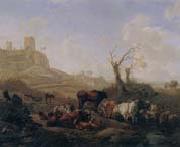 |
William Romeyn -- Click Here
|
|
Haarlem circa 1624-circa 1694
|
|
 |
William Rimmer -- Click Here
|
|
1816-1879
William Rimmer Gallery
William Rimmer (20 February 1816?C20 August 1879) was an American artist born in Liverpool, England. He was the son of a French refugee, who emigrated to Nova Scotia, where he was joined by his wife and child in 1818, and who in 1826 moved to Boston, where he earned a living as a shoemaker. The son learned the father's trade; at fifteen became a draughtsman and sign-painter; then worked for a lithographer; opened a studio and painted some ecclesiastical pictures.
In 1840 Rimmer made a tour of New England painting portraits, he lived in Randolph, Massachusetts, in 1845-1855 as a shoemaker, for the last years of the decade practising medicine; practised in East Chelsea, Massachusetts and received a diploma from the Suffolk County Medical Society and in 1855 removed to East Milton, Massachusetts where he supplemented his income by carving busts from blocks of granite.
In 1860 Rimmer made his head of St. Stephen and in 1861 his Falling Gladiator. Rimmer's sculptures, except those mentioned and The Fighting Lions, A Dying Centaur, and a statue of Alexander Hamilton (made in 1865 for the city of Boston), were soon destroyed. He worked in clay, not modelling but building up and chiselling; almost always without models or preliminary sketches; and always under technical disadvantages and in great haste; but his sculpture is anatomically remarkable and has an early Greek simplicity and strength.
Rimmer published Elements of Design (1864) and Art Anatomy (1877), but his great work was in the classroom, where his lectures were illustrated with blackboard sketches.
Rimmer's most famous work, though not normally associated with him, is Evening: Fall of Day. This paint-on-canvas portrays Apollo, and a modified version was used by Swan Song Records, the recording label founded in 1974 by English rock group Led Zeppelin, in their label art. It is often mistaken to be a picture of Icarus, Lucifer, Satan, or Daedalus |
|
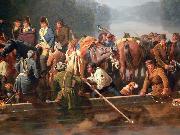 |
William Ranney -- Click Here
|
|
(May 9, 1813 - November 18, 1857) was a 19th-century American painter, known for his depictions of Western life, sporting scenery, historical subjects and portraiture. In his 20-year career, he made 150 paintings and 80 drawings, and is considered the first major genre painter to work in New Jersey, and one of the most important pre-Civil War American painters.His work is on display in several museums across the United States. One of his contemporaries opined, "A specimen of Ranney is indispensable wherever a collection of American art exists." |
|
|
|
|
| | |
|
|
|
|